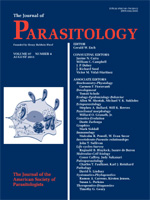The nematode Skrjabinoptera phrynosoma is a stomach parasite of horned lizards in the genus Phrynosoma. This nematode demonstrates a distinctive life cycle wherein entire gravid females harboring infective eggs exit with lizard feces. Pogonomyrmex spp. harvester ants collect these females and feed them to their larvae, which are the only stages of the intermediate host that can become infected. We hypothesized that the seasonal dynamics of nematode abundance within lizard hosts would be correlated with the seasonal availability of suitable intermediate hosts. To describe seasonal variation of nematode population variables and elucidate the timing of critical events in the parasite life cycle, nematodes were collected from both hosts across three collection periods in the ant-and-lizard activity season of 2008 in the Alvord Basin of southeastern Oregon. Among 3 collection periods, and across the activity season, nematodes were harvested from individual Phrynosoma platyrhinos, and the distribution of developmental categories and body lengths of nematodes was analyzed to determine the seasonal change in nematode population composition. Pogonomyrmex spp. ants were collected in pit-fall traps and dissected to determine infection prevalence. The abundance of non-gravid female and juvenile nematodes collected from lizards' stomachs decreased significantly between the early and late collection period, which was likely a consequence of the sequential conversion of these developmental categories to gravid females. The presence of gravid female nematodes peaked in cloacal and fecal collections during mid-season. The body lengths of male nematodes increased as the activity season progressed, perhaps due to growth, but their abundance remained the same. Smaller juvenile nematodes were present in late-season collections from lizards, possibly indicating new acquisitions from infected ants. We propose that once a set population of male nematodes establishes in lizards' stomachs, newly acquired juvenile nematodes develop into non-gravid females that mate, become gravid females, and exit the lizard mid-season. We additionally suggest that the exit of females may be timed with the peak foraging activity of ant intermediate hosts and access to larval ants in the nests. Infection prevalence in the intermediate host was low, with only 1 of 6,000 dissected harvester ants containing a single larval nematode. The temporal dynamics of S. phrynosoma populations within P. platyrhinos at this northern locale is most likely driven by the seasonal availability of harvester ant intermediate hosts.
How to translate text using browser tools
1 August 2011
Seasonal Dynamics of Skrjabinoptera phrynosoma (Nematoda) Infection in Horned Lizards From the Alvord Basin: Temporal Components of a Unique Life Cycle
K. Claire Hilsinger,
Roger A. Anderson,
Dana Nayduch
ACCESS THE FULL ARTICLE

Journal of Parasitology
Vol. 97 • No. 4
August 2011
Vol. 97 • No. 4
August 2011




